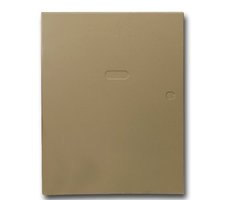System Sensor 5621
135°F Fixed Temp / Rate of Rise Heat Detector

Description
The System Sensor 5621 is a dual-circuit, fixed-heat, and rate-of-rise heat detector. The 5621 will indicate an alarm if the temperature exceeds 135℉ (57℃) and/or the temperature rises 15℉ (~8.3℃) or more per minute. In addition to an alarm circuit, the 5621 also offers an auxiliary circuit.
Heat detectors are not considered life-safety devices, but they are used to warn of a fire in areas where smoke detectors should not be used. These areas include garages, outbuildings, kitchens, and even bathrooms. Although you want to be alerted if a fire occurs in these areas, the environment is not suitable for the installation of smoke detectors. Noxious fumes present in garages and outbuildings smoke from cooking in kitchens, and steam in bathrooms can all lead smoke detectors, particularly photoelectric smoke detectors, to indicate a false alarm. Heat detectors are perfect for use in these areas instead.
Unlike smoke detectors, heat detectors do not require power. They are simple mechanical devices with a Normally Open (NO) circuit. They can connect to nearly any hardwired alarm panel zone. They can even sometimes be connected to a wireless transmitter, such as the Honeywell 5817CBXT. Once the sensor is connected, if the 5621 senses heat outside of the acceptable parameters, the open circuit of the heat detector will close, completing the alarm circuit. This will cause the alarm panel to indicate a fire alarm when properly programmed.
Because the 5621 is a Normally Open device, it is always recommended that it be used on an alarm circuit that requires end-of-line resistor (EOLR) supervision. Different panels may require different resistor values, so check the documentation to see what your alarm panel requires. Normally Open devices should have their resistor wired in parallel, and it should be wired across the terminals of the last device on the circuit. This means if you have multiple System Sensor 5621 devices in use, you can connect them all to a single panel zone, with the proper resistor connected at the last 5621 in the line. The resistor will have a wire sticking out of each side. One of these wires will connect to one of the heat detector terminals, and the other wire will connect to the other heat detector terminal. You can also connect each 5621 to a separate zone. If you choose to wire in this way, each 5621 should have its own resistor, with the resistor for each one connected in the same manner described above.
The fixed temperature sensor in the System Sensor 5621 is non-restoring. That means when it activates the 5621 has to be replaced. Therefore, you cannot perform a functional test on that feature of the detector. On the other hand, the rate-of-rise sensor is auto-restoring. If a rate-of-rise alarm event occurs, the sensor will restore automatically once the temperature returns to normal. For this reason, you can perform a functional test of the rate-of-rise sensor on the 5621. This can be accomplished using a hairdryer set on its highest setting or a heat gun. But beware, if you happen to activate the fixed temperature portion of the sensor, the unit will have to be replaced. Be very careful if you decide to test the detector in this way. Refer to the installation instructions for more information on testing.
The System Sensor 5621 is a dual-circuit device. That means that instead of a single normally open output, it has two normally open outputs. Each of these outputs behaves in exactly the same way. One is meant to be used as the alarm circuit when the heat detector is being connected to an alarm panel. The other output can be used to connect to an auxiliary device. An example of an auxiliary device might be an access control system. When connected to an access control system, a short on the auxiliary output of the System Sensor 5621 could cause the access control system to automatically unlock a door for fire egress for occupants or fire department ingress. When working with fire devices, even non-life-safety devices such as heat detectors, it is always a good idea to read Limitations of Fire Alarm Systems, provided by System Sensor.
If you'd like to have a dual-circuit heat detector with a fixed temperature threshold only, then check out the System Sensor 5624. This sensor also has a dual-circuit output, with both being normally open, but it has a fixed heat threshold of 194℉ (90℃) and no rate-of-rise feature built-in. If you prefer having both types of technology in the detector, but you'd like a single circuit, then look at the System Sensor 5602. You might also check out the System Sensor 5601P, which has the same 135℉ (57℃) fixed temperature activation and rate-of-rise detection as the System Sensor 5621, but the System Sensor 5601P is a single-circuit sensor while the System Sensor 5621 is a dual-circuit sensor.
Specifications
- Sensor Type: Hardwired Heat
- Number of Circuits: Dual Normally Open (NO) Circuits
- Fixed Temperature Threshold: 135℉ (57℃), Non-Restoring Single Use
- Rate-of-Rise Threshold: 15℉ (~8.3℃) or Higher Rise Per Minute, Self-Restoring Multi-Use
- UL Maximum Spacing (10-foot ceiling): 50' x 50' (15.2m x 15.2m)
- Operating Voltage/Contact Ratings (Resistive): 6 - 125 VAC / 3A ; 6 - 28 VDC / 1A ; 125 VDC / 0.3A ; 250VDC / 0.1A
- Maximum Installation Temperature: 150℉ (65.6℃)
- Operating Humidity: 5 to 95% Relative Humidity Non-Condensing
- Wire Gauge Supported by Terminals: 14 - 22 AWG
- Back Box Mounting: 3.5" octagonal ; 4" octagonal ; Single Gang ; 4" square with a square to round plaster ring
- Dimensions (w/Mounting Bracket): Diameter: 4.57" (11.6cm) ; Height: 1.69 inches (4.3cm)
- Weight: 6 oz. (170g)
- SKU: BK-5621
Brand: System Sensor



